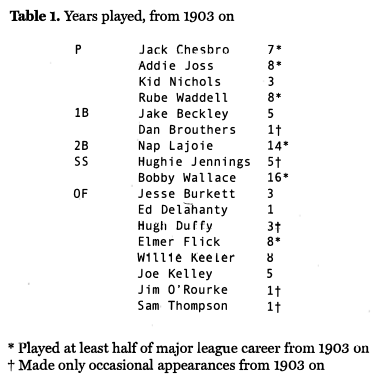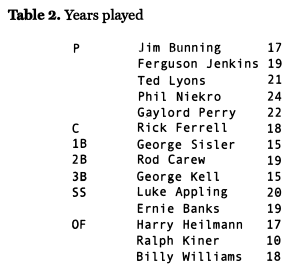Hall of Famers Who Never Played in the World Series
This article was written by Bobby Fong
This article was published in 2003 Baseball Research Journal
The Chicago Cubs’ latest pennant near-miss continues to deny Sammy Sosa, a certain Hall of Famer, an appearance in the World Series. Sammy may yet share the dubious distinction of fellow Cub Ernie Banks, the best-known example of a Hall of Fame player who never played in the World Series. Actually, there have been 31 Cooperstown honorees with playing time since 1903, when the modern World Series was inaugurated, who never participated in the fall classes.
Seventeen of these players had major league experience prior to 1903. The following chart lists them and the number of years they played from 1903 on:
Five players were 19th-century stars whose appearances from 1903 on were cursory. Jim O’Rourke and Dan Brouthers played for the 1904 New York Giants with the encouragement of John McGraw, O’Rourke suiting up for one game, Brouthers for two. Similarly, Sam Thompson appeared in eight games for the 1906 Detroit Tigers. Hugh Duffy and Hughie Jennings played occasionally after each had become a coach or manager, Duffy in 34 games over three seasons, and Jennings in 11 games between 1903 and 1918. Jennings did manage the 1907 to 1909 Tigers, who played in and lost three consecutive World Series.
Ed Delahanty was a regular with the 1903 Washington club, but his career was cut short by his mysterious death at Niagara Falls in the midst of the season. Kid Nichols, Jake Beckley, Jesse Burkett, and Joe Kelley played three to five seasons from 1903 on, but they were on the downside of their careers and on teams that did not win pennants.
By contrast, six players played at least half of their careers after 1903. Three, Addie Joss, Nap Lajoie, and Elmer Flick, were Cleveland teammates from 1902 to 1910. Despite their presence, the closest the club came to winning a pennant was 1908, when it finished a half-game behind the Tigers because Detroit was not required to make up a rainout.
Jack Chesbro suffered from bad timing: he jumped from the Pittsburgh Pirates to the New York Highlanders (later the Yankees) before the 1903 season, the year that the Pirates won the pennant and played in the first World Series. Then in 1904, Chesbro made the infamous wild pitch that cost the Highlanders a chance at the pennant on the last day of the season.
His teammate that day was Wee Willie Keeler, who spent seven of his eight post-1902 seasons with the Highlanders, which would not appear in a World Series until 1921. Bobby Wallace played 16 years for the St. Louis Browns and Cardinals from 1903 on. The Cards played in their first World Series in 1926, the Browns in 1944, long after Wallace had retired.
Perhaps the most agonizing near miss, however, happened to Rube Waddell. He was the ace of the 1905 Philadelphia Athletics staff, going 26-5 to lead them to the American League pennant. Unfortunately, late in the season he got into a scuffle with a teammate and hurt his arm. He did not pitch in the Series as the A’s lost to the Giants.
The Hall of Fame credentials of Joss, Lajoie, Flick, Chesbro, Waddell, and Wallace were largely compiled after the commencement of the modern World Series, and thus they represent the first wave of players whose careers were not capped by an appearance in the Fall Classic. More were to come.
Fourteen Hall of Famers played their entire careers in the modern era without appearing in the Series:
Ted Lyons and Luke Appling share with Ernie Banks the distinction of HOFers playing their entire careers with a club that never won the pennant. Lyons and Appling were also longtime teammates on the Chicago White Sox, which went 40 years between World Series appearances.
To date, the Chicago Cubs have gone 58 years since their last fall classic appearance in 1945. That lack of fortune affected not only Banks but also Fergie Jenkins and Billy Williams, longtime Cubs and teammates of Banks. Their trades to other clubs never made up for those years of futility with Chicago.
Similarly, Harry Heilmann spent 15 of his 17 years in the majors with the Detroit Tigers during a period when the club went 25 years between pennants. And Ralph Kiner spent eight seasons of his brief ten-year career with the Pittsburgh Pirates during a period when that franchise went 33 years between pennants.
By contrast, from 1929 to 1947, Rick Ferrell played for the Browns, Red Sox, and Senators. Each club won one pennant during this period, but Ferrell was never on the right team when it cashed in. George Kell played for five teams from 1943 to 1957, but the nearest he ever came to a World Series were three second-place finishes with Detroit, finishing no closer than three games out in 1950.
George Sisler came closest to the Series in 1922 when the St. Louis Browns finished one game behind the New York Yankees. Jim Bunning was a member of the 1964 Philadelphia Phillies, thought to be locks for the pennant until their late-season collapse.
With the introduction of division play in 1969, players like Rod Carew, Phil Niekro, Billy Williams, and Gaylord Perry actually made it into the post-season, but Carew was on the losing side in four League Championship Series, Niekro on two, and Williams and Perry on one apiece.
Gaylord Perry’s nearest miss, however, was not in the LCS. In his rookie season of 1962, the San Francisco Giants won the pennant and met the Yankees in the World Series. Gaylord had spent most of the season in the minors before his call-up in September. He contributed three wins to the San Francisco effort that year and played a part in helping the Giants overtake the Dodgers, with whom the Giants finished in a tie at the end of the regular season before beating them in a three-game playoff. But Perry had been called up too late to make the post-season roster! He pitched batting practice during the Series, but he was not eligible to play. Perhaps even Ernie Banks would have preferred not coming that close.
A member of SABR since 1984, BOBBY FONG is president of Butler University, Indianapolis, Indiana.
A World Series Without Hall of Famers?
The flip-side of Bobby Fong’s article is all of the World Series in which no Hall of Famer participated. The first occurrence of this came in the 1890 Series between the NL champion Brooklyn Bridegrooms and the American Association champion Louisville Colonels. The Players’ League champion of 1890, the Boston Reds, were not invited to participate in the Series; if they had, then their Hall of Fame triumvirate of Dan Brouthers, Charlie Radbourn, and King Kelly would have prevented 1890 from having this dubious distinction.
Other World Series with no Hall of Fame players are recent ones in which most players are not yet eligible for election. The Series with the lowest chance of having a participant end up in the Hall was the 1997 edition between the Marlins and Indians. The best candidates from those teams were Gary Sheffield, Manny Ramirez, Jim Thome, and Kevin Brown, none of whom is a certainty.
If we examine World Series champions only, then the first championship team not to have anyone in the Hall was the 1981 Dodgers (the 1890 WS ended in a tie, three wins apiece). The 1984 Tigers (Jack Morris?), the 1988 Dodgers (Orel Hershiser?), 1997 Marlins, the 1998 Yankees (Derek Jeter? Mariano Rivera?), and the 2002 Angels(?) are excellent candidates to join the 1981 Dodgers on this list.
Excluding the most recent Series, there have been 11 champions with only one player enshrined in Cooperstown — the winners of the very first World Series in 1884, the Providence Grays, with Radbourn as their sole representative; the 1886 St. Louis Browns (Charley Comiskey); the 1919 Reds (Edd Roush); the 1940 Reds (Ernie Lombardi); the 1943 Yankees (Bill Dickey); the 1944 Cardinals (Stan Musial); the 1979 Pirates (Willie Stargell); the 1982 Cardinals (Ozzie Smith); the 1985 Royals (George Brett); the 1986 Mets (Gary Carter); and the 1987 Twins (Kirby Puckett).
The championship team with the most Hall of Famers was the 1932 Yankees with nine (Earle Combs, Dickey, Lou Gehrig, Lefty Gomez, Tony Lazzeri, Herb Pennock, Red Ruffing, Babe Ruth, and Joe Sewell). There have been seven champions with six Hall of Famers who participated in the World Series: the 1888 and 1889 New York Giants (Roger Connor, Buck Ewing, Tim Keefe, Jim O’Rourke, John Ward, and Mickey Welch); the 1927 Yankees (Combs, Gehrig, Waite Hoyt, Lazzeri, Pennock, and Ruth), the 1928 Yankees (Combs, Leo Durocher, Gehrig, Hoyt, Lazzeri, and Ruth); the 1934 Cardinals (Dizzy Dean, Durocher, Frankie Frisch, Jesse Haines, Joe Medwick, and Dazzy Vance); and the 1936 and 1937 Yankees (Dickey, Joe DiMaggio, Gehrig, Gomez, Lazzeri, and Ruffing).
The most Hall of Fame players on a World Series losing team was seven, infamously achieved by the 1924 Giants (Frisch, Travis Jackson, George Kelly, Fred Lindstrom, Bill Terry, Hack Wilson, and Ross Youngs).
And the most Cooperstown inductees from both teams in one World Series occurred in 1932 when the Chicago Cubs added four (Kiki Cuyler, Burleigh Grimes, Gabby Hartnett, and Billy Herman) to the Yankees’ nine to make a likely never-to-be-broken record of 13.
— Jean-Pierre Caillault




